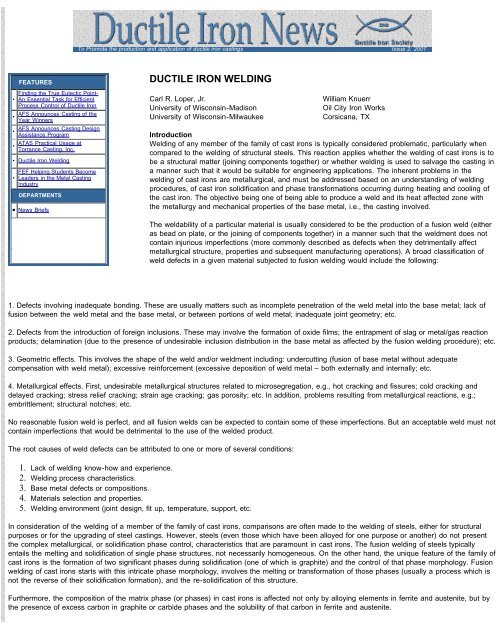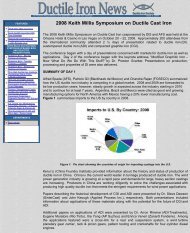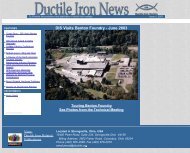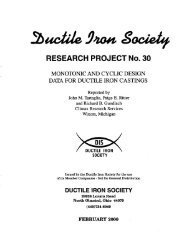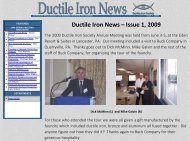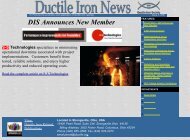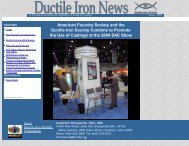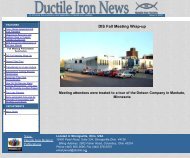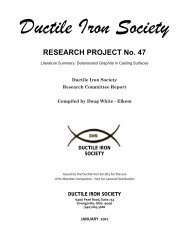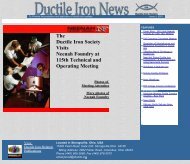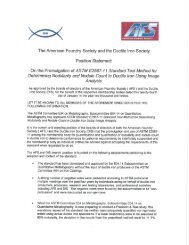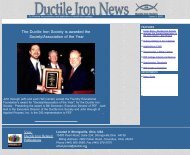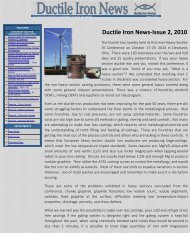Create successful ePaper yourself
Turn your PDF publications into a flip-book with our unique Google optimized e-Paper software.
To Promote the production and application of ductile iron castings <strong>Issue</strong> 2, <strong>2007</strong><br />
FEATURES<br />
Finding the True Eutectic Point-<br />
• An Essential Task for Efficient<br />
Process Control of <strong>Ductile</strong> <strong>Iron</strong><br />
•<br />
AFS Announces Casting of the<br />
Year Winners<br />
•<br />
AFS Announces Casting Design<br />
Assistance Program<br />
•<br />
ATAS Practical Usage at<br />
Torrance Casting, Inc.<br />
• <strong>Ductile</strong> <strong>Iron</strong> Welding<br />
FEF Helping Students Become<br />
• Leaders in the Metal Casting<br />
Industry<br />
DEPARTMENTS<br />
• News Briefs<br />
• Advertisers<br />
• Back <strong>Issue</strong>s<br />
DUCTILE<br />
• DIS Home Page<br />
IRON WELDING<br />
Carl R. Loper, Jr.<br />
University of Wisconsin-Madison<br />
University of Wisconsin-Milwaukee<br />
William Knuerr<br />
Oil City <strong>Iron</strong> Works<br />
Corsicana, TX<br />
Introduction<br />
Welding of any member of the family of cast irons is typically considered problematic, particularly when<br />
compared to the welding of structural steels. This reaction applies whether the welding of cast irons is to<br />
be a structural matter (joining components together) or whether welding is used to salvage the casting in<br />
a manner such that it would be suitable for engineering applications. The inherent problems in the<br />
welding of cast irons are metallurgical, and must be addressed based on an understanding of welding<br />
procedures, of cast iron solidification and phase transformations occurring during heating and cooling of<br />
the cast iron. The objective being one of being able to produce a weld and its heat affected zone with<br />
the metallurgy and mechanical properties of the base metal, i.e., the casting involved.<br />
The weldability of a particular material is usually considered to be the production of a fusion weld (either<br />
as bead on plate, or the joining of components together) in a manner such that the weldment does not<br />
contain injurious imperfections (more commonly described as defects when they detrimentally affect<br />
metallurgical structure, properties and subsequent manufacturing operations). A broad classification of<br />
weld defects in a given material subjected to fusion welding would include the following:<br />
1. Defects involving inadequate bonding. These are usually matters such as incomplete penetration of the weld metal into the base metal; lack of<br />
fusion between the weld metal and the base metal, or between portions of weld metal; inadequate joint geometry; etc.<br />
2. Defects from the introduction of foreign inclusions. These may involve the formation of oxide films; the entrapment of slag or metal/gas reaction<br />
products; delamination (due to the presence of undesirable inclusion distribution in the base metal as affected by the fusion welding procedure); etc.<br />
3. Geometric effects. This involves the shape of the weld and/or weldment including: undercutting (fusion of base metal without adequate<br />
compensation with weld metal); excessive reinforcement (excessive deposition of weld metal – both externally and internally; etc.<br />
4. Metallurgical effects. First, undesirable metallurgical structures related to microsegregation, e.g., hot cracking and fissures; cold cracking and<br />
delayed cracking; stress relief cracking; strain age cracking; gas porosity; etc. In addition, problems resulting from metallurgical reactions, e.g.;<br />
embrittlement; structural notches; etc.<br />
No reasonable fusion weld is perfect, and all fusion welds can be expected to contain some of these imperfections. But an acceptable weld must not<br />
contain imperfections that would be detrimental to the use of the welded product.<br />
The root causes of weld defects can be attributed to one or more of several conditions:<br />
1. Lack of welding know-how and experience.<br />
2. Welding process characteristics.<br />
3. Base metal defects or compositions.<br />
4. Materials selection and properties.<br />
5. Welding environment (joint design, fit up, temperature, support, etc.<br />
In consideration of the welding of a member of the family of cast irons, comparisons are often made to the welding of steels, either for structural<br />
purposes or for the upgrading of steel castings. However, steels (even those which have been alloyed for one purpose or another) do not present<br />
the complex metallurgical, or solidification phase control, characteristics that are paramount in cast irons. The fusion welding of steels typically<br />
entails the melting and solidification of single phase structures, not necessarily homogeneous. On the other hand, the unique feature of the family of<br />
cast irons is the formation of two significant phases during solidification (one of which is graphite) and the control of that phase morphology. Fusion<br />
welding of cast irons starts with this intricate phase morphology, involves the melting or transformation of those phases (usually a process which is<br />
not the reverse of their solidification formation), and the re-solidification of this structure.<br />
Furthermore, the composition of the matrix phase (or phases) in cast irons is affected not only by alloying elements in ferrite and austenite, but by<br />
the presence of excess carbon in graphite or carbide phases and the solubility of that carbon in ferrite and austenite.


